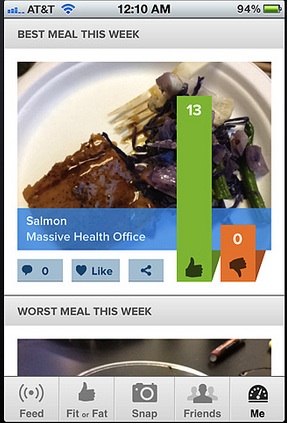 Less than 3 percent of early users of The Eatery, the first app from app maker Massive Health, which was acquired by Jawbone in February 2013, used it often enough to be considered active users, and of those, only about 10 percent showed an improvement in the healthiness rating of their meals, according to a new study in JMIR.
Less than 3 percent of early users of The Eatery, the first app from app maker Massive Health, which was acquired by Jawbone in February 2013, used it often enough to be considered active users, and of those, only about 10 percent showed an improvement in the healthiness rating of their meals, according to a new study in JMIR.
This is an especially interesting finding, as the company's unique approach to food tracking had driving up engagement as a primary goal. Using The Eatery app, users took pictures of their food and uploaded them to a social network within the app wherein other users rated them as "Fat" or "Fit."
“We build things that people are going to love to use," Massive Health head of business development Andrew Rosenthal told MobiHealthNews in 2011. "Our approach has always been to focus on user engagement partly because no one else does. The more someone loves something, the more they use it, and the more opportunities we will have as a company to help them be healthy.”
Update: After publication of the story, a Jawbone spokesperson pointed out that the study looked at a representative sample, not the totality of the app's users. We've clarified the language below.
Massive Health made available to researchers the data from the 200,000 users who downloaded the app between October 15, 2011 and April 3, 2012. That sample doesn't contain all users, since Massive Health continued to operate the app at least through its February 2013 acquisition. Massive Health always referred to the app as an "experiment" and not as a fully-baked product.
According to the JMIR study, 69 percent of people who downloaded the app didn't take a single picture of food. Another 17 percent took only one picture. Of the remaining users, 11 percent were classified as semi-active: They took between 2 and 10 pictures and used the app for less than a week. Only 2.58 percent of users, or about 5,000 people, took 10 or more pictures and used the app for more than a week.
There were some predictors for active users: They were more likely to begin using the app during the day on on weekdays, they were more likely to have strict diets, and they were more likely to include a caption for their first picture. The researchers suggest this might be because the dedicated users were already healthier eaters.
"The dietary preferences reported on the initial use were also connected to adherence level," they wrote in the study. "Users who reported a 'strict' diet (low fat, low/no carbs, or vegan/vegetarian) were most likely to become active users. They also gave 21 percent of all ratings, although only 9 percent of all users belonged to the strict group. Hence, it is possible that users with strict diets were already most interested in healthy eating. This is also supported by their healthiness ratings: active users with strict diets had higher average healthiness ratings for their first picture and also higher average healthiness ratings for all pictures than users in other dietary preference groups."
Some of those same predictors affected which active users showed an improvement in the healthiness ratings of their foods between when they begin using the app and when they stopped.
"Among the 4,863 active users who had at least one valid picture as their first or second picture, 481 (9.89 percent) had a significant positive trend in healthiness scores," researchers wrote. "These 'improvers' differed from other 'actives' by having a higher total number of pictures ..., a longer usage period in days ..., and a higher number of pictures per day... In other words, they used the app for a longer time and did dietary self-monitoring more frequently. Users with 'strict' diets had higher healthiness scores than users in other dietary preference categories and they also had the highest proportion of 'improvers'."
This is the latest study to question whether wellness apps and devices are really showing meaningful engagement. A study released earlier this month by Endeavour Partners suggests that one third of wearable activity tracker owners stop using their device within six months of buying it.















